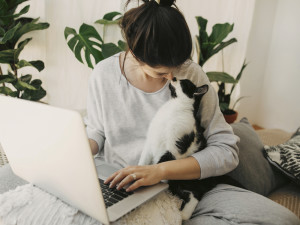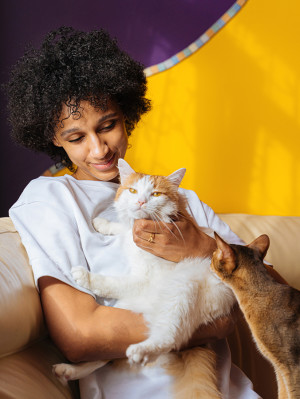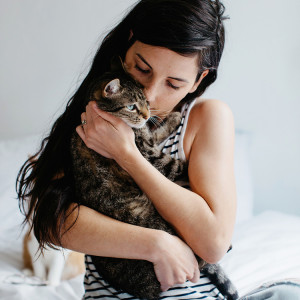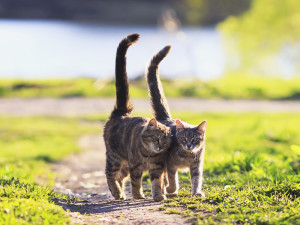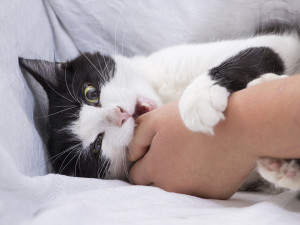Why Does My Cat Rub His Face on My Face?
You’re gettin’ awfully close there, pal.
In This Article:
The Science Behind Cat Face-Rubbing Types of Cat-Rubbing Behaviors How to Tell If Your Cat Loves You When Face-Rubbing Might Indicate Problems Frequently Asked Questions
When your cat rubs their face against yours, it’s a multifaceted gesture of affection, scent-marking, and communication. This behavior, known as bunting (or head-butting), is your cat’s way of marking you with their scent, showing trust, and reinforcing your bond as part of their feline family.
But there’s a lot more behind your cat’s actions than simply rubbing up against your face and getting fur on your nose (sneeze!). What causes your cat to want to make this gesture, and what does it meanopens in new tab, precisely? Well, when it comes to many of your cat’s actions, a lot of it comes down to scent and scent-marking. Let’s take a look at how cats use scent and what it all means.
Save on the litter with color-changing tech that helps you better care for your cat.
The science behind face-rubbing
When your cat rubs their face on something (whether it’s your leg, your face, or the corner of your laptop screen as you try to work), they deposit scent, both their own individual scent and pheromones. These scents are a big part of cat communication and can convey many different messages.
How much do you spend on your pet per year?
What are cat pheromones?
Pheromones are chemical messages that can change the behavior of the recipient of that message. Pheromones are spread when a cat rubs their face or body on an object (via scent glands on the face and flanks), when a cat scratches and kneads (via interdigital scent glands), and when a cat pees or poops (for example, when a cat urine-sprays an object in their territory).
These messages can convey information about a cat’s location and territory, their reproductive status (if they’re ready to find a mate), and social messaging (for example, “claiming” a human as a part of their family as an affectionate act).
Scent glands in cats’ faces
Cats have scent glands in several locations on their face,opens in new tab including their cheeks, around the mouth, and on the chin. They also have glands on their forehead between the ears and eyes. When your cat rubs their face on an object, these glands are stimulated and pheromones are released.
Types of cat-rubbing behavior
Why do cats rub their face on things? Because there are so many different locations of scent glands on a cat and so many different types of things cats have to say with pheromone messages, there are several ways you might see your cat rubbing on things. Here are just a few of those behaviors:
Why is my cat rubbing their face on everything?
One of the feline facial pheromones is used for marking territory. If you see your cat rubbing their face on everything in sight, this could be a sign that your cat has some territorial insecurity. A cat who is insecure about their territory wants to leave their scent on everything, including objects along well-traveled pathways in your home; specific objects that smell like other cats, animals, or people; or anything else that may help them feel more territorially secure.
Why do cats rub against your legs?
Rubbing up against their human’s legs is a common behavior of many cats. It may be a sign of scent-marking their favorite person, but it can also indicate that the cat wants something… like food. Have you ever noticed how your cat gets more affectionate when they’re expecting a meal? Rubbing up against your legs might be a way of getting your attention and providing reminders!
Why do cats rub their face on corners?
Corners of walls and furniture often occur along commonly-traveled pathways in your home, which are favorite places for cats to place their scent-marks. They’ll often rub corners that other cats have rubbed on before them to add their scent to the sign-post. If you look at your walls about a foot off the ground, you may see a slight discoloration on the corner; an indication that your cats have been marking corners with their faces.
Why is my cat at rubbing their mouth on me?
The feline mouth has a lot of scent glands surrounding it, and sometimes cats can use their mouths for intense marking. My cats will often purr and rub up against my hands with their mouth slightly open in a gesture of affection and scent-marking.
How to tell if your cat loves you
Cats will often useopens in new tab some of the same behaviors, whether they’re interacting with humans or cats. But how do cats show affection? Head-butting, bunting, and nuzzling can all be signs that your cat loves you! But there are additional ways that you can tell your furry family member thinks you’re... the cat’s meow
Vocalizations
Does your kitty greet you with meows, chirps, or perhaps even purrs when they see you? Cats have a wide variety of vocalizations and they will utilize the friendliest of those sounds to tell you that they’re happy to see you.
Kneading
Making biscuits, happy paws, and kneading are all terms for the same thing: the contented flexing of paws when a cat is settling down for a nap or snooze. If your cat takes the time to knead while sitting on a blanket on your lap, you can take this as a huge compliment; your cat sees you as a safe and calm element in their environment. Plus, with those interdigital scent glands, your cat is probably scent-marking you as well as getting comfy.
Body language
Relaxed, easy-going body language is also another sign that your cat loves being around you. If your cat lays down near you with their belly exposed or facing away from you without the need for vigilance, your cat is comfortable in your presence. Greeting you with a tail up and pep in their step are sure signs your cat feels the love.
When face-rubbing might indicate problems
Like any number of cat behaviors, it’s possible that face-rubbing could indicate medical or behavioral issues that need to be addressed. As mentioned above, excessive rubbing could potentially mean that your kitty is feeling insecure in their territory, making sure that your cat’s environmental and social needs are being met can help them feel more secure. But excess rubbing can also indicate potential health issues, too.
Excessive rubbing and potential health issues
Excessive rubbing can be caused by physical discomfort, such as an allergic reaction to a particular food, fleas, or substance in the environment. It may also be a response to pain, such as with a dental problem or skin infection, or even a neurological condition. Injuries may also cause face-rubbing, as with something in the eyes or ears. Face-rubbing may also be a form of over-grooming, which can be a stress response or other indicator of medical distress.
Changes in rubbing behavior
Facial rubbing is a common behavior in cats that they perform on a regular, daily basis. But if you notice that the frequency of rubbing has increased, is prolonged, or has intensified, that’s an indicator that something has changed in your cat’s world. It could be an environmental change that is making your kitty want to reinforce their territorial markings, or it could be a medical issue.
When to consult a veterinarian
With any change in your cat’s behavior, it’s never a bad idea to talk with your veterinarian. If you see an increase in the frequency or intensity of head or face-rubbing, it may be time for a veterinary exam to ensure that your kitty isn’t suffering from a medical condition that needs to be addressed.
FAQs (People also ask):
How do cats show affection?
Cats show their affection in several ways, including head-bunting (or head-butting), making friendly vocalizations or purring, kneading, and expressing relaxed body language. Whether your kitty is exhibiting these behaviors to humansopens in new tab or other cats, the meaning is the same: it’s love!
How do cats mark you?
Cats scent-mark their humans by rubbing up against them using their face, flanks, and even their paws. Rubbing using cheeks, mouth, or forehead is called head-bunting (or head-butting), and cats can use these areas (as well as their sides as they walk) to mark their people on their face, head, legs, or almost anywhere else. Even kneading deposits scent-marks by dispersing scent from interdigital (between toe-bean) scent glands.


